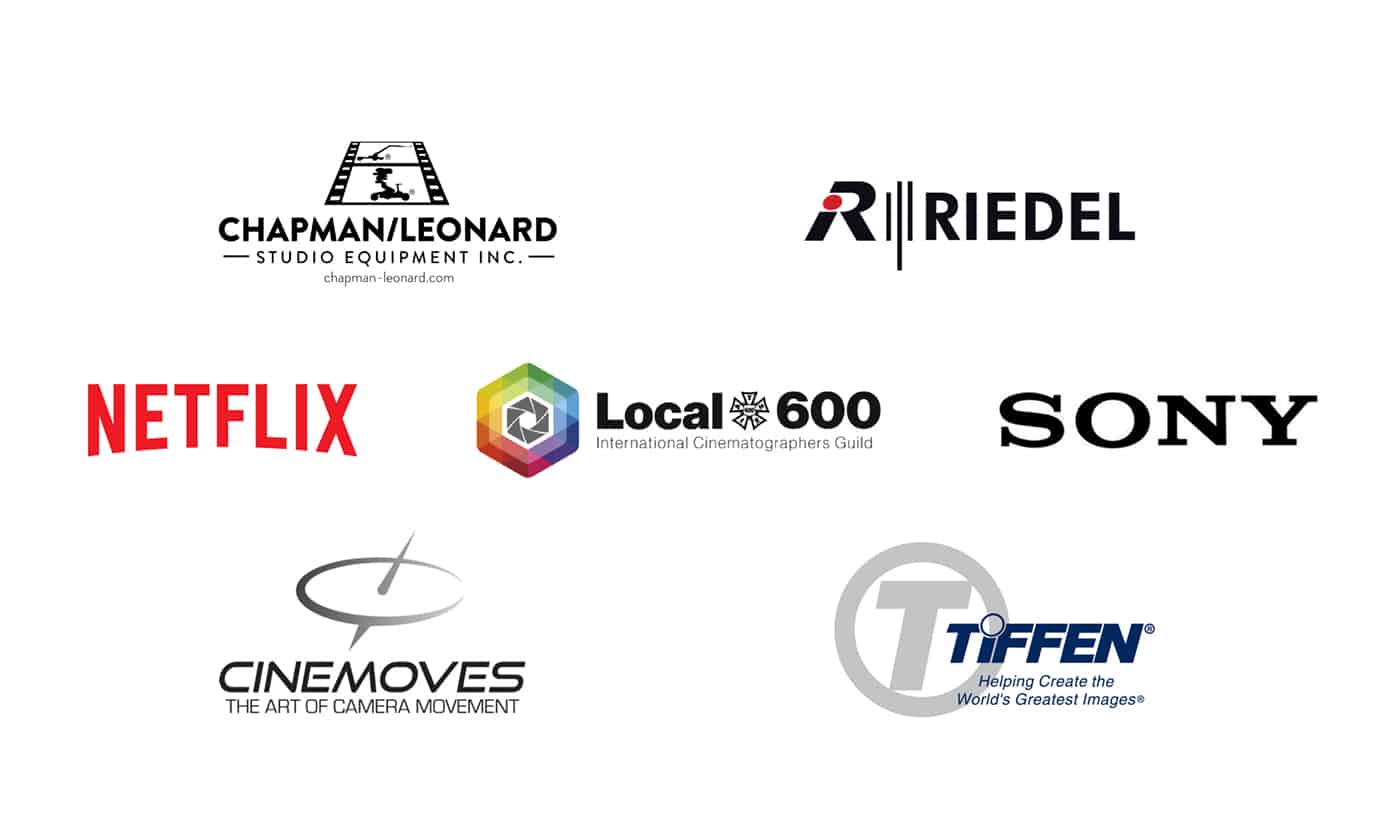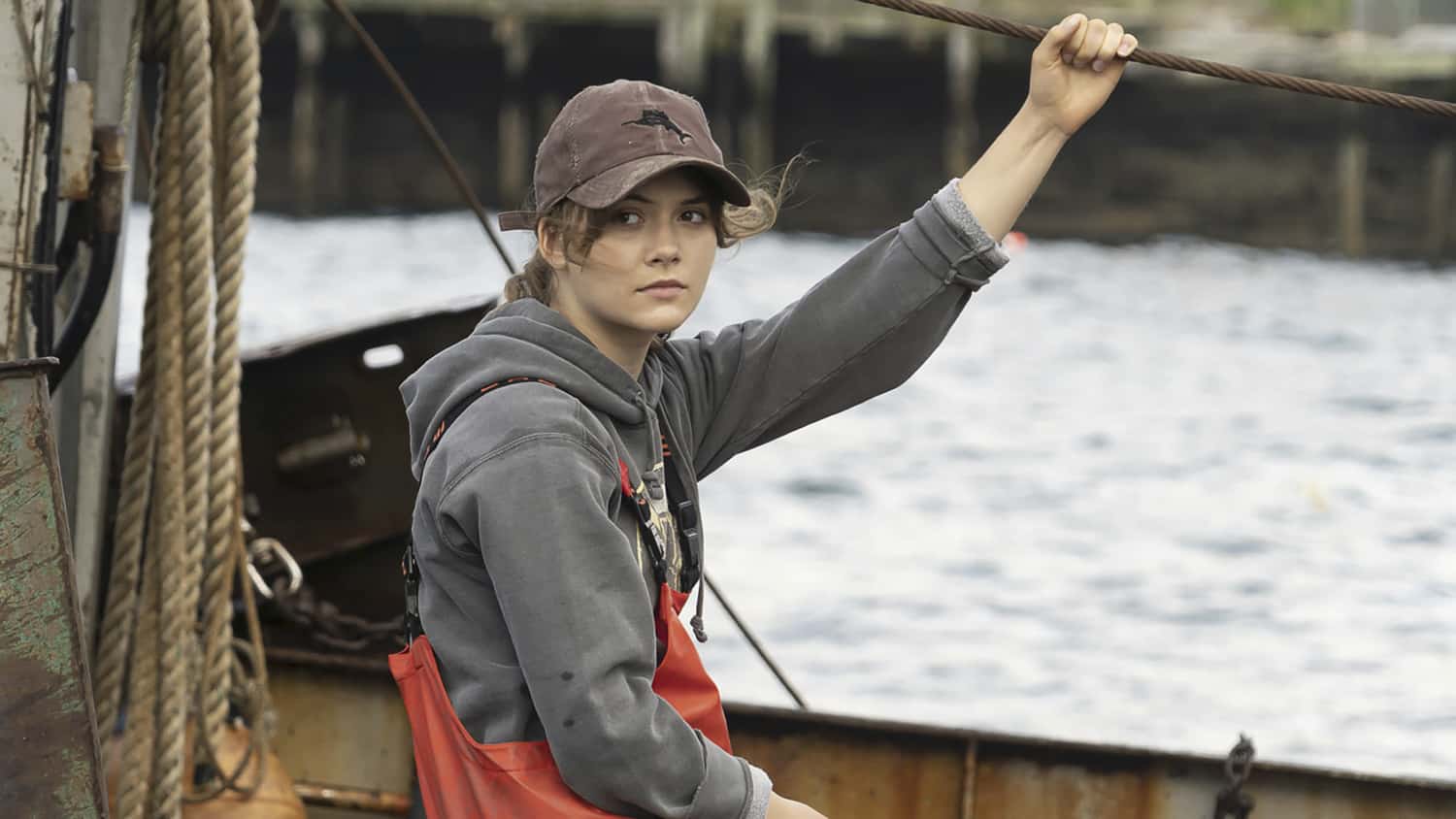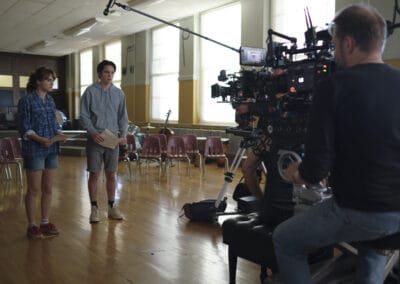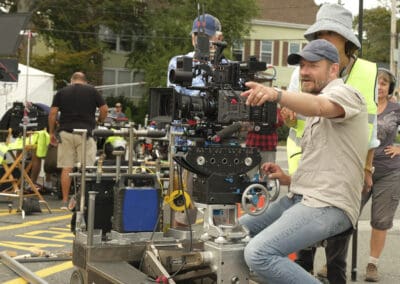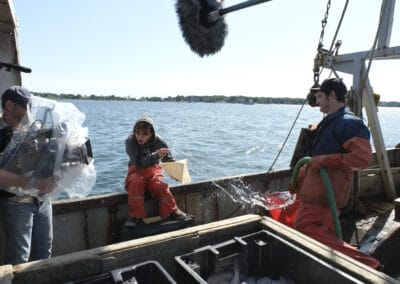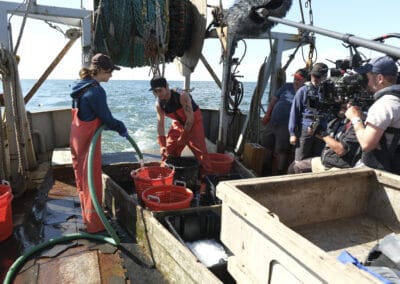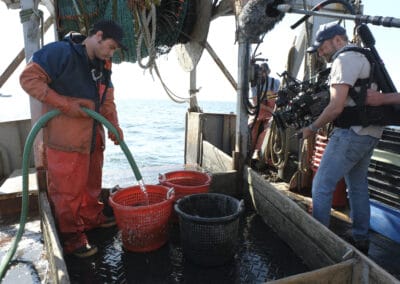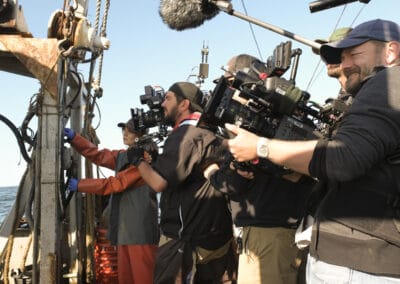CODA: Learning a New Cinematic Language
By Alec Jarnagin, SOC
CODA [Child of Deaf Adult(s)] is a coming-of-age story set in Gloucester, Massachusetts, that follows Ruby Rossi through her senior year in high school as she balances being the only hearing member of her family, working on her family’s fishing boat, and exploring her talents as a gifted singer, all while navigating the struggles of her first love.
CODA was written and directed by Siân Heder and is loosely based on the French film La Famille Belier. The film stars Emilia Jones as Ruby Rossi, Troy Kotsur as Frank Rossi, Daniel Durant as Leo Rossi, Marlee Matlin as Jackie Rossi, Eugenio Derbez as Bernardo “Mr. V” Villalobos, Ferdia Walsh-Peelo as Miles, Amy Forsyth as Gertie, and Kevin Chapman as Brady.
CODA has been nominated for three Academy Awards: Best Picture, Best Actor in a Supporting Role (Troy Kotsur), and Best Adapted Screenplay (Siân Heder).
In this article, A camera and Steadicam operator Alec Jarnagin talks about the making of CODA. To ground the film in the reality of the deaf experience, writer/director Siân Heder was insistent that the film be cast with actors who are genuinely deaf. With that came challenges and a steeper-than-usual learning curve, but also a unique opportunity to question some of the standard filmic conventions and create a cinematic style that embraces a language that is seen rather than heard.
Also of note are the challenges that came with shooting on fishing boats, in historic houses, and under pandemic restrictions.
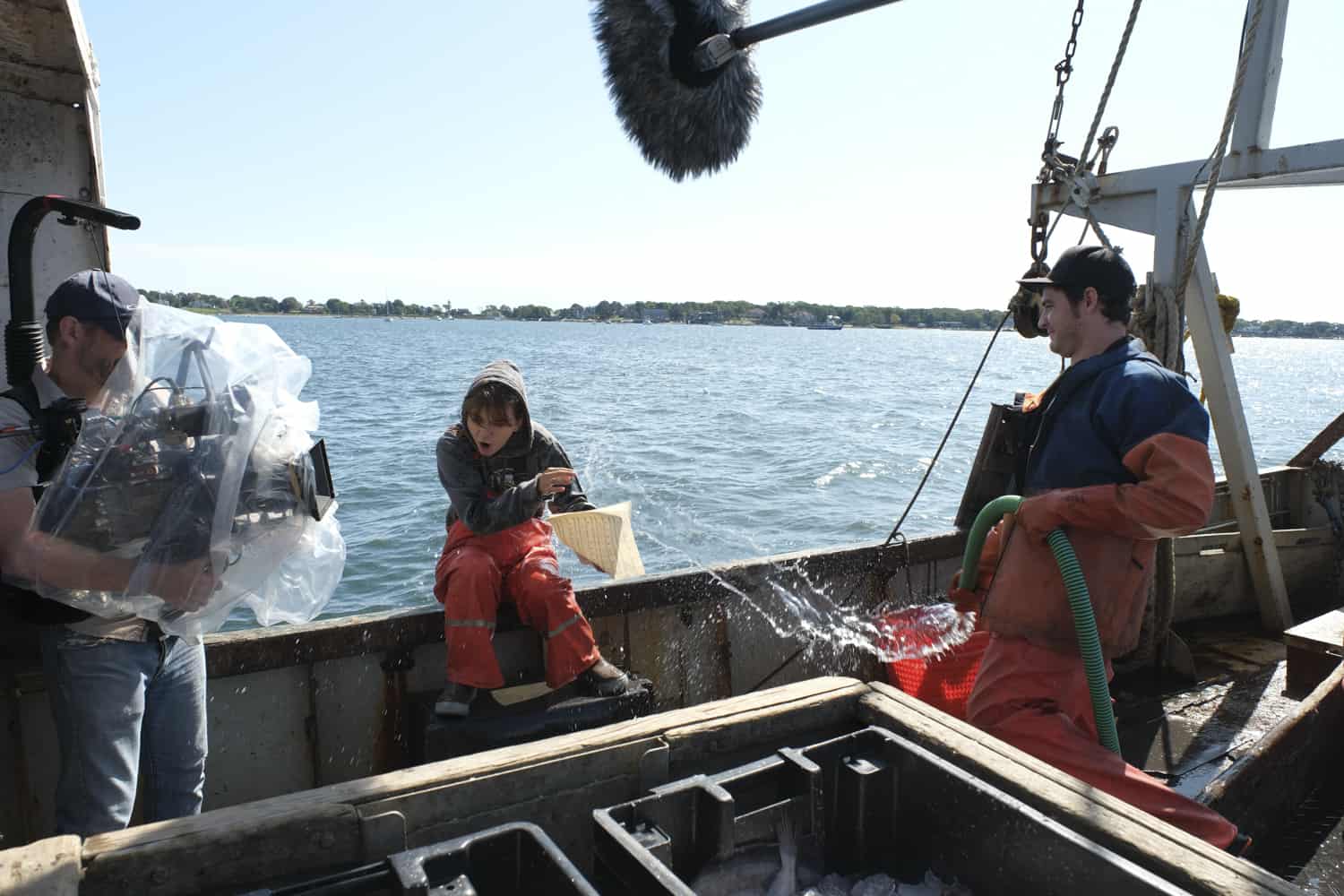
Alec Jarnagin, SOC, on the set of CODA. Photo by Mark Hill
It was the summer of 2019 when cinematographer Paula Huidobro reached out to me regarding the upcoming production of CODA. Paula had asked her old friend and fellow DP and AFI alumni Tobias Datum for recommendations. Tobi and I had done two projects together with Director Paul Weitz (Bel Canto and the final season of Mozart in the Jungle) and he thought Paula and I would make a good fit. So, Paula and I arranged a meeting over Skype and this is when I first learned the story of CODA. The story fascinated me—I’ve always been a sucker for a good coming-of-age story—and Paula and I hit it off. The film was originally going to be a studio picture, but with Siân’s insistence on casting actors who were actually deaf—Marlee Matlin has said “deafness is not a costume you can put on”—they couldn’t figure out a financing model that worked for them, as most of the cast would be “unknowns.” In the end, the film was produced independently and would go on to win multiple awards at Sundance, resulting in its sale to Apple.
We shot the film entirely on location in Gloucester, Massachusetts, in six weeks utilizing a mostly local crew. I had started my career in the Boston area, having grown up in Concord, Massachusetts, so I was excited about the possibility of seeing some of my old friends on the crew, although it had been over twenty years since I moved to New York City. As it turned out, Massachusetts was very busy, so many of my “usual suspects” were on other projects. We were fortunate that the film Free Guy was wrapping, however, so we were able to secure key grip Frank Montisanto and dolly grip Mike Moad (aka “Moadie”) as well as our A camera first AC Christian Hollyer. Additionally, second AC Chuck Moya, whom I had worked with on many occasions, had just relocated to Massachusetts from New York City, so I was happy to have a familiar face as the A camera second assistant.
What is a closeup? It occurred to Siân, Paula, and I that we would need to rethink this convention for many of the scenes in the film, as they would take place utilizing solely ASL (American Sign Language). We needed to keep the hands in frame at all costs, as that is the only way for the dialogue to be captured! There is no such thing as an offscreen line with ASL, and Siân pointed out that the commonly used cinematic device of a “reaction shot” was also not a possibility for these scenes. This said, Siân feels that ASL is perhaps the most cinematic language in existence, calling it “pure cinema.” We chose an aspect ratio of 2:1 allowing for a slightly taller frame than 2.40, helping us keep those hands in frame yet still wide enough to include the family in group shots.
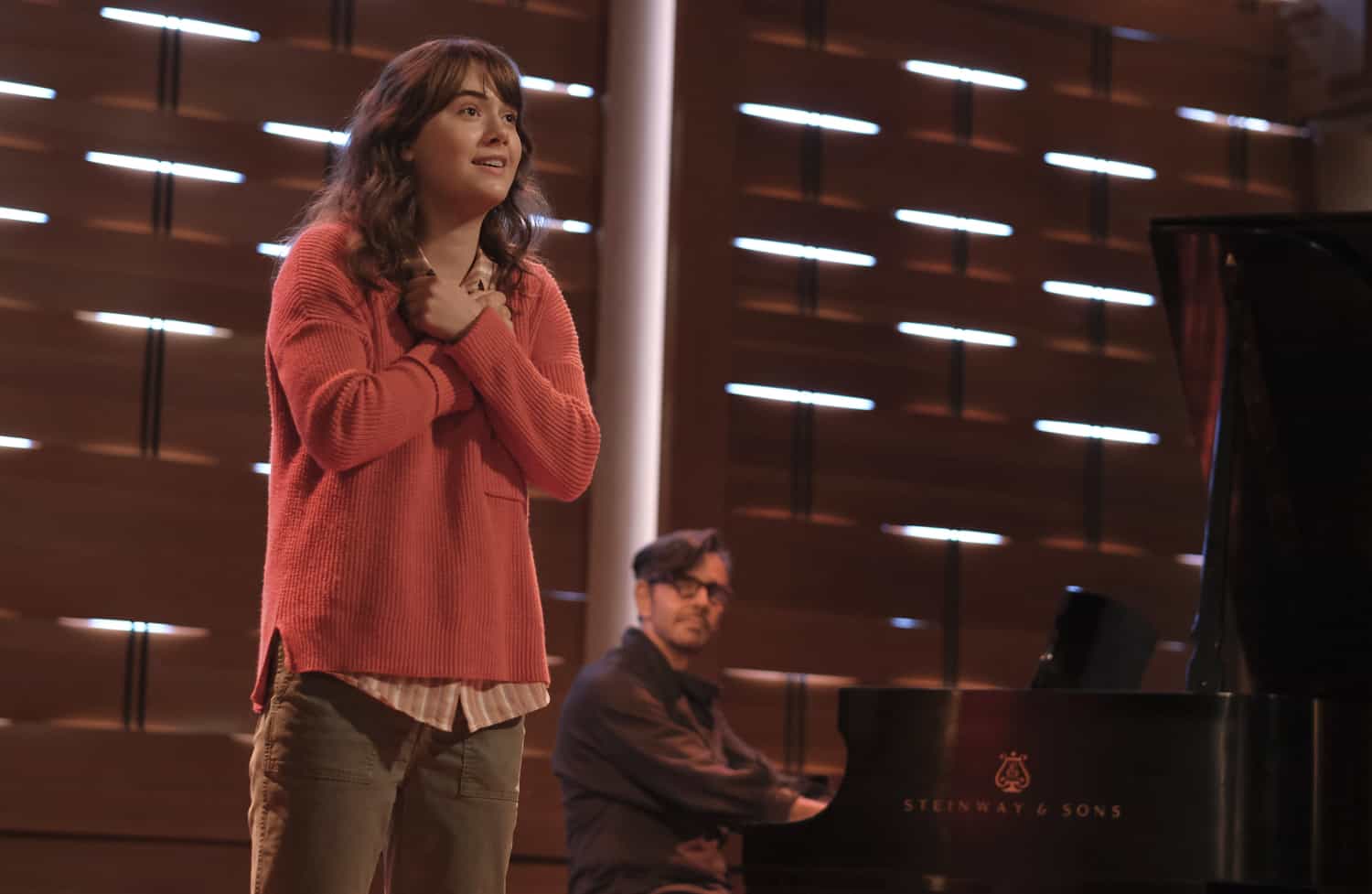
Emilia Jones as Ruby Rossi in CODA. Photo courtesy of Apple
Having a front-row seat to the filming of these scenes was amazing. The rapport our actors had with one another was truly genuine, and it is no wonder that the chemistry between the family in the finished film works so well. CODA’s entire cast was spot on. I couldn’t believe Emilia’s performance as Ruby—I was truly in awe. Emilia is British (complete with accent), didn’t know any ASL prior to landing the role (she’d spent nine months training), nor had she known how to sing. Oh, and she learned to fish and run a boat, too—yes, that’s all real. I’ve seen a lot of amazing performances over my career, but watching Emilia day-in and day-out was truly up there. Similarly, actors Troy and Daniel as her father and brother spent multiple days at sea before filming began, learning to fish and navigate their way around the boat. Troy’s performance as the father often had me stifling laughs, but no scene with him moved me as much as when Ruby sings to her father, sitting in the back of their pickup truck under the stars. Having just attended Ruby’s first school concert—where Siân boldly has the sound drop out, placing us firmly in Ruby’s family’s world—Frank wants to be included, so he asks Ruby what the song she sang was about. In a very tender moment, Frank places his hands on his daughter’s vocal cords as she sings “You’re All I Need to Get By.” Of course with our schedule, it was late at night when we got to this scene and we had precious little time. I think we did it in one or two takes.
Marlee Matlin’s performance as Ruby’s mother was another one I shall remember for years to come. Two moments stand out to me as if they were yesterday. On the back porch of the house, Ruby tells her mother that she has joined the choir, to which she responds, “You’re a teenager. If I was blind, would you want to paint?” And later, in Ruby’s bedroom, Marlee’s character reveals to Ruby that she had secretly hoped for her to be deaf when she was born.
There was definitely a learning curve as an operator on this film. I tend to wear headsets with a feed from the sound department so I can hear the film I’m helping create. For this, we had ASL translators (who were all CODAs themselves) over the headset speaking the ASL lines, but the delay made it useless to me, so I quickly abandoned this process. Communicating with the actors was surprisingly easy once you embraced a bit of deaf culture. You need something? Walk up to them and put your hand on them to get their attention and sign, gesture, or do whatever you have to do to make your point. I truly loved working with this cast. Siân had taught me how to introduce myself as the camera operator in ASL. When I greeted Daniel Durant (Ruby’s brother Leo) this way, he offered up a huge smile. Daniel was always warm and welcoming. I remember after he first saw the Steadicam, he pointed to me and mimicked a “strong man.” Speaking of Steadicam and Daniel, I think one of the most pivotal scenes in the film is when Ruby and Leo have an argument about her going to college. At this point she has decided to stay and help the family business, while Leo scolds her and tells her the family will be fine without her, and she needs to leave. We’d lost the original location for this scene so Siân suggested we shoot it at sunset by the water at scenic Lane’s Cove in Gloucester. Siân rehearsed the actors until the light was right and then we rolled the camera on a Steadicam to allow the actors as much freedom as possible. I truly love this scene between brother and sister.
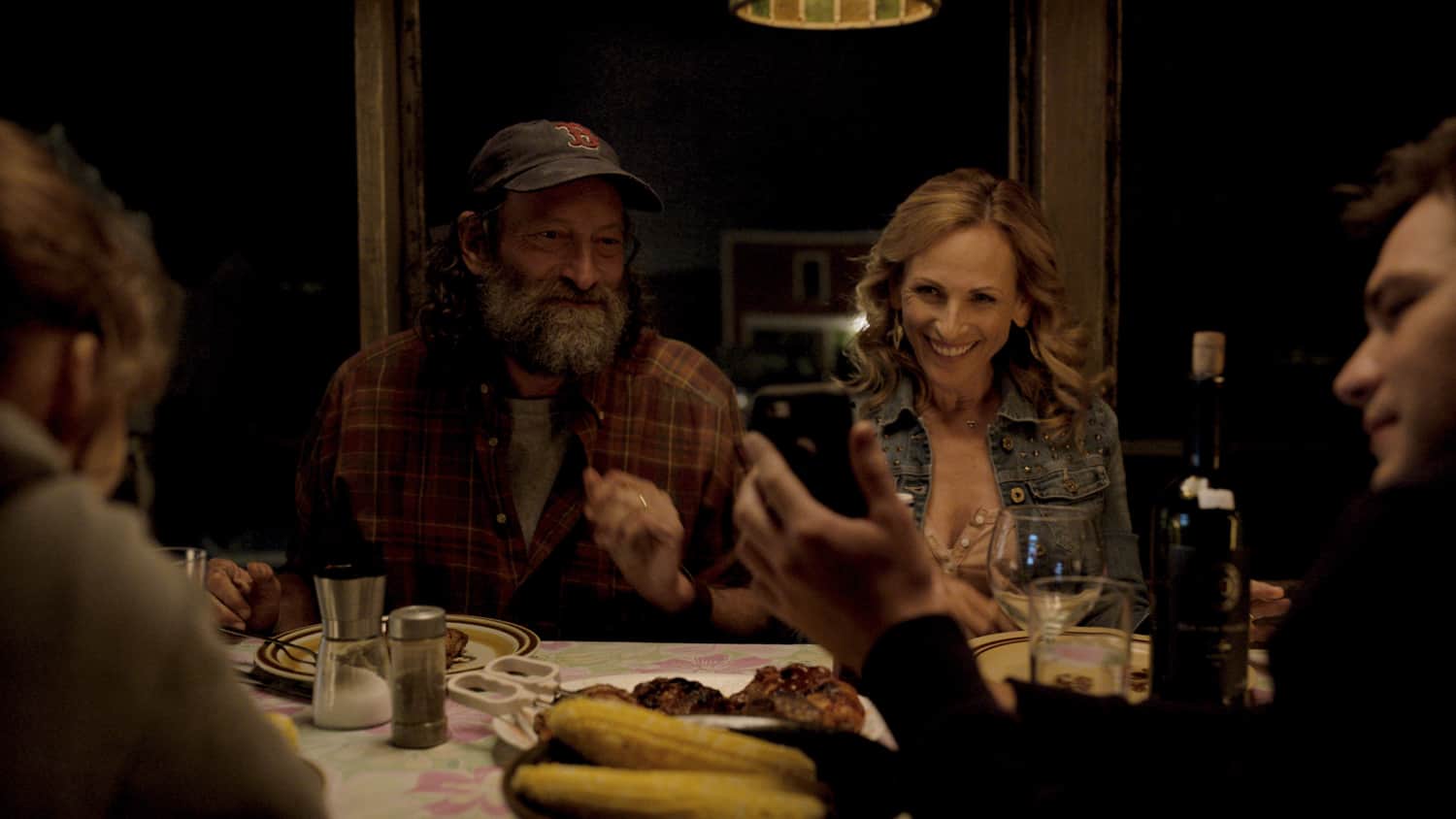
Emilia Jones, Tony Kotsur, Marlee Matlin, and Daniel Durant in CODA. Photo courtesy of Apple
The family house in the film is a practical location that ironically would prove to be good COVID protocol training. The upper floor of the house was in such decay that we were only allowed to have ten people in there at any given time. Departments would each take their turn, one at a time, while first AD David Mendoza stood perched atop a ladder. This technically made him “on the first floor,” since none of the ladder’s weight rested on the upper floor, but allowed him to be eye level with the second-floor balcony. Most of the scenes in the house were either handheld or fluid head on a slider because the dolly weighed too much, whereas everything at the high school was geared head and dolly or Steadicam. Siân preferred the camera movement to be motivated by the actors’ movement. Paula and I agreed; so much beauty was already coming from the story and characters that we didn’t want to get in the way. She’d say, “Bring the beauty from the story as opposed to imposing something on it!”
Legend has it that when Siân first met with marine coordinator Joe Boreland, he suggested the family be lobsterpersons, as it would be much easier to film in a comfortable harbor. Siân wasn’t interested in that, so we had an armada of seven boats instead. The Angela Rose is an actual fishing boat and what you see in the film is actual fishing—three miles out to sea with three to five-foot waves! The “real-life” captain was aboard, just off-camera. We were allowed 15 people on board at any given time, which, after the three cast members, didn’t leave room for a lot of crew. Siân, Paula, first AD David Mendoza, myself, A camera first AC Christian Hollyer, B camera operator Scott Lebeda, B camera first AC Nolan Ball, and key grip Frank Montisanto were about it. Anytime we needed something that wasn’t on the Angela Rose (or someone needed to use a bathroom since there were none on the boat) we’d have to do a ship-to-ship transfer and send the transport to the base ship, which was a whale-watching boat. I can see why Steven Spielberg didn’t make another boat movie after Jaws . . . . Similar to the family house, and all the shots on the boat in Jaws, we opted to shoot the scenes on the boat handheld. In my experience, locking the camera to the deck with a tripod, for example, makes the viewer seasick. Similarly, a Steadicam or stabilized head, which keep a perfect horizon, have the result of exaggerating the movement between the boat and horizon. Handheld allows for the operator’s body to absorb some of the motion, while finding the balance between boat movement and horizon.
We’d wake before dawn, meet at the dock, board the boats, and set out to sea. Three miles out, the captain of the Angela Rose would drop the fishing nets into the sea and we’d wait for an hour or so as the nets were hopefully filling with fish. When the time and light were right, Scott (the B op) and I would throw the cameras on our shoulders and our cast would pull up the nets. Due to real-life fishing regulations, there were limits on how many times we could do this, what was done with the fish, etc. Once again, the amazing cast shined. For the scene where the Coast Guard boards the Angela Rose, we’d cast a real-life “Coastie.” He drove the Coast Guard boat in real-time as a “oner,” and what you see in the film is real, boarding and all. On the first take, he came in a little too hot and when he bumped the Angela Rose hard, his windows shattered! So, we had to knock out all the glass remains from the window before we could do another take. If you look closely, you can see that there is no glass.
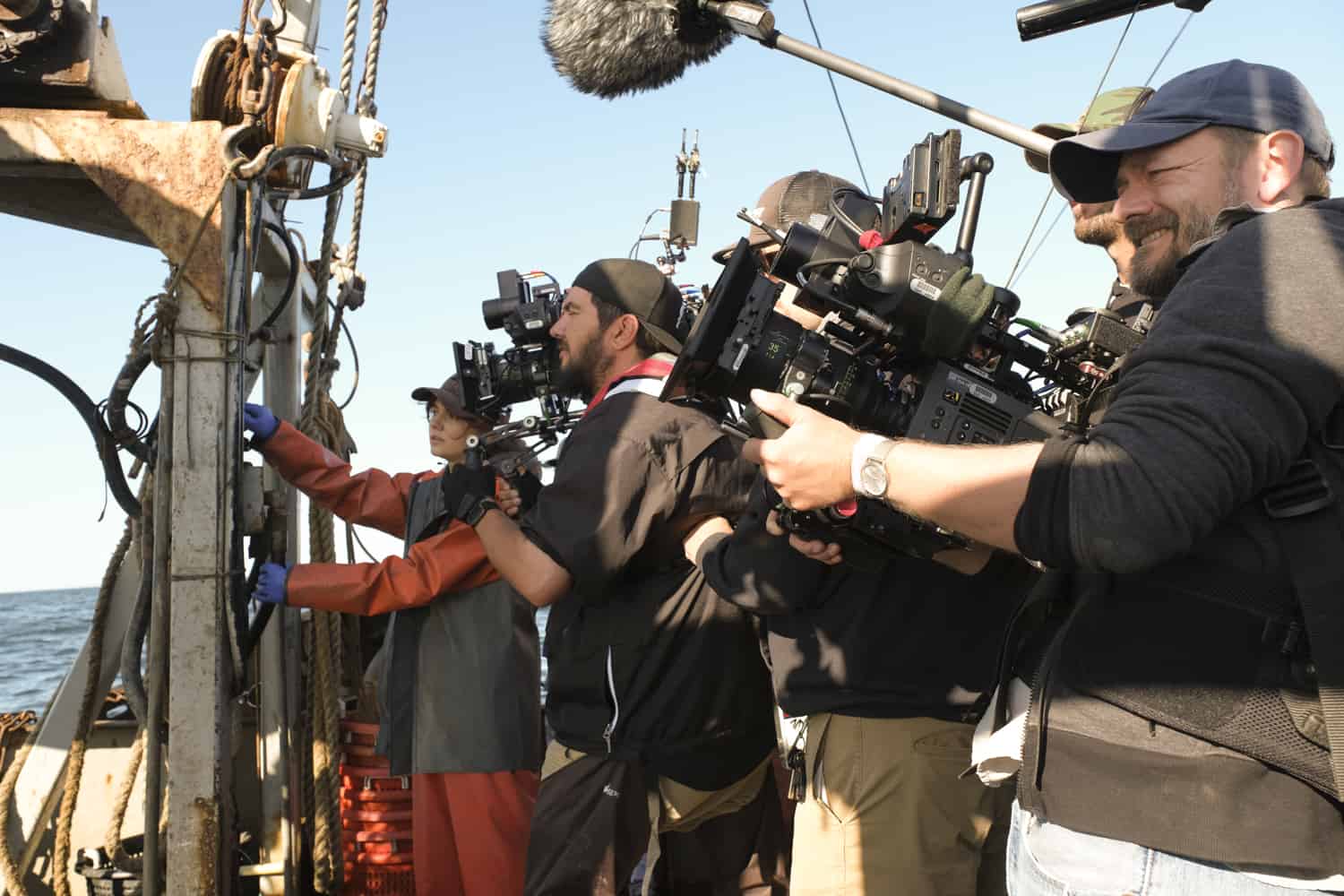
Alec Jarnagin, SOC, on the set of CODA. Photo by Mark Hill
We obviously needed to shoot the Angela Rose from the water as well. For this we employed a barge that key grip Frank Montisanto and dolly grip Mike Moad rigged with a Panther Foxy Crane and Libra Head. We didn’t have long to get these shots, but it really sells the story. Moadie would swing that arm around with such grace while I was on the wheels. Refusing to be left out of the fun, B camera operator Scott Lebeda “went fishing” for additional coverage, utilizing an Angenieux 24-290 Optimo Ultra 12x. I believe this is the only time we used this lens, favoring our ARRI Signature Primes for everything else.
We also used the Panther Foxy Crane and Libra Head on a much smaller barge when we shot the rock quarry scenes. There, Moadie and I had some of our most fun collaborations, catching the kids jumping from the cliffs or rolling on a log for their first kiss. The dolly grip/camera operator relationship is so important and when it’s right, it is just so special. Mike Moad is one of the greats and we were so lucky to have him!
When I got to see CODA for the first time, thankfully in a theater, I was very happy we took a few hours on the last day of shooting to capture Ruby riding her bike throughout Gloucester, a feat we accomplished by rigging the Steadicam to an ATV. Like the crane shots of the Angela Rose, it adds a lot of production value to the picture. The whole film looks great, and it’s a testament to the entire team that helped make it happen. Paula and gaffer Ben Heald’s technique of lighting through windows and using practicals allowed our actors tremendous freedom. Our on-set dresser, Adam Roffman, was always next to the camera looking for ways to improve the frame. First ACs Christian and Nolan did amazing work.
Like every project I do, I was able to learn new lessons and expand my skills, but more than that, CODA gave me the unique opportunity to immerse myself in a new language and culture. When I first read CODA, I knew it was going to be something special, but I had no idea the journey it would take me on or that it would end up with three Oscar nominations. I am extraordinarily proud to have played a part in making this movie, and I couldn’t be happier for Siân and the whole crew that brought this story to life.
Camera Operator Spring 2022
Above Photo: Emilia Jones in CODA
TECH ON SET
Sony Venice Shot at 6K, 2:1 Aspect Ratio
ARRI Signature Prime Lenses
XCS Ultimate Sled
GPI PRO Arm & Vest
Panther Foxy Crane
Libra Head
Angenieux 24-290 Optimo Ultra 12x
RELATED CONTENT
Alec Jarnagin, SOC
BEHIND THE SCENES
Select Photo for Slideshow
Alec Jarnagin, SOC
Alec Jarnagin, SOC, is an A camera/Steadicam operator based in Brooklyn New York. Alec began his career as a film electrician in Boston Massachusetts. He got his start as a cinematographer shooting independent productions and high-end corporate videos and learning Steadicam from his mentor, Charles Papert, over 25 years ago. He moved to New York in 1997 when he was ready to focus on working as a camera operator on larger productions. Alec worked on numerous New York TV series and films as B camera/Steadicam operator alongside many great A operators until he mastered the skills to gain confidence in the role of A camera operator, the position in which he has been working for over 10 years. Alec has worked with many extraordinary cinematographers, including Fred Murphy, ASC; Seamus McGarvey, ASC, BSC; Richard Crudo, ASC; Nancy Schreiber, ASC; Martin Ahlgren, ASC; Alan Caso, ASC; Eric Edwards; Pete Konzal; and Chris Manley, ASC. Alec is married to cinematographer Jendra Jarnagin.For more information about Alec and to see his work and list of credits, please visit floatingcamera.com.
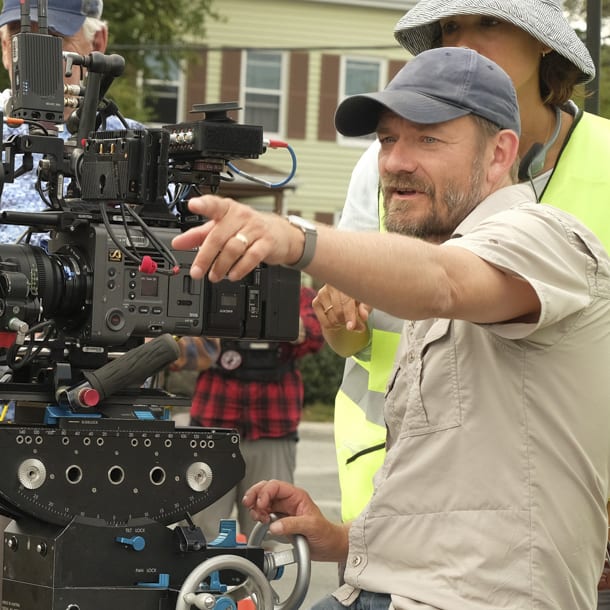
SPECIAL THANKS TO OUR ADVERTISERS
